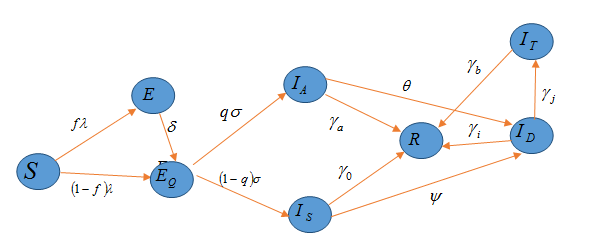Modelling the transmission dynamics of Omicron variant of COVID-19 in densely populated city of Lagos in Nigeria
Keywords:
Epidemiological model, deterministic modelAbstract
The kernel of the work in this article is the proposition of a model to examine the effect of control measures on the transmission dynamics of Omicron variant of coronavirus disease in the densely populated metropolis of Lagos. Data as relate to the pandemic was gathered as officially released by the Nigerian authority. We make use of this available data of the disease from 1st of December, 2021 to 20th of January, 2022 when omicron variant was first discovered in Nigeria. We computed the basic reproduction number, an epidemiological threshold useful for bringing the disease under check in the aforementioned geographical region of the country. Furthermore, a forecasting tool was derived, for making forecasts for the cumulative number of cases of infection as reported and the number of individuals where the Omicron variant of COVID-19 infection is active for the deadly disease. We carried out numerical simulations of the model using the available data so gathered to show the effects of non-pharmaceutical control measures such as adherence to common social distancing among individuals while in public space, regular use of face masks, personal hygiene using hand sanitizers and periodic washing of hands with soap and pharmaceutical control measures, case detecting via contact tracing occasioning clinical testing of exposed individuals, on the spread of Omicron variant of COVID-19 in the city. The results from the numerical simulations revealed that if detection rate for the infected people can be increased, with majority of the population adequately complying with the safety protocols strictly, then there will be a remarkable reduction in the number of people being afflicted by the scourge of the highly communicable disease in the city.

Published
How to Cite
Issue
Section
Copyright (c) 2023 Bolarinwa Bolaji, B. I. Omede, U. B. Odionyenma, P. B. Ojih, Abdullahi A. Ibrahim

This work is licensed under a Creative Commons Attribution 4.0 International License.
How to Cite
Most read articles by the same author(s)
- Bolarinwa Bolaji, Abdullahi Ibrahim, Favour Ani, Benjamin Omede, Godwin Acheneje, A model for the control of transmission dynamics of human monkeypox disease in Sub-Saharan Africa , Journal of the Nigerian Society of Physical Sciences: Volume 6, Issue 2, May 2024







